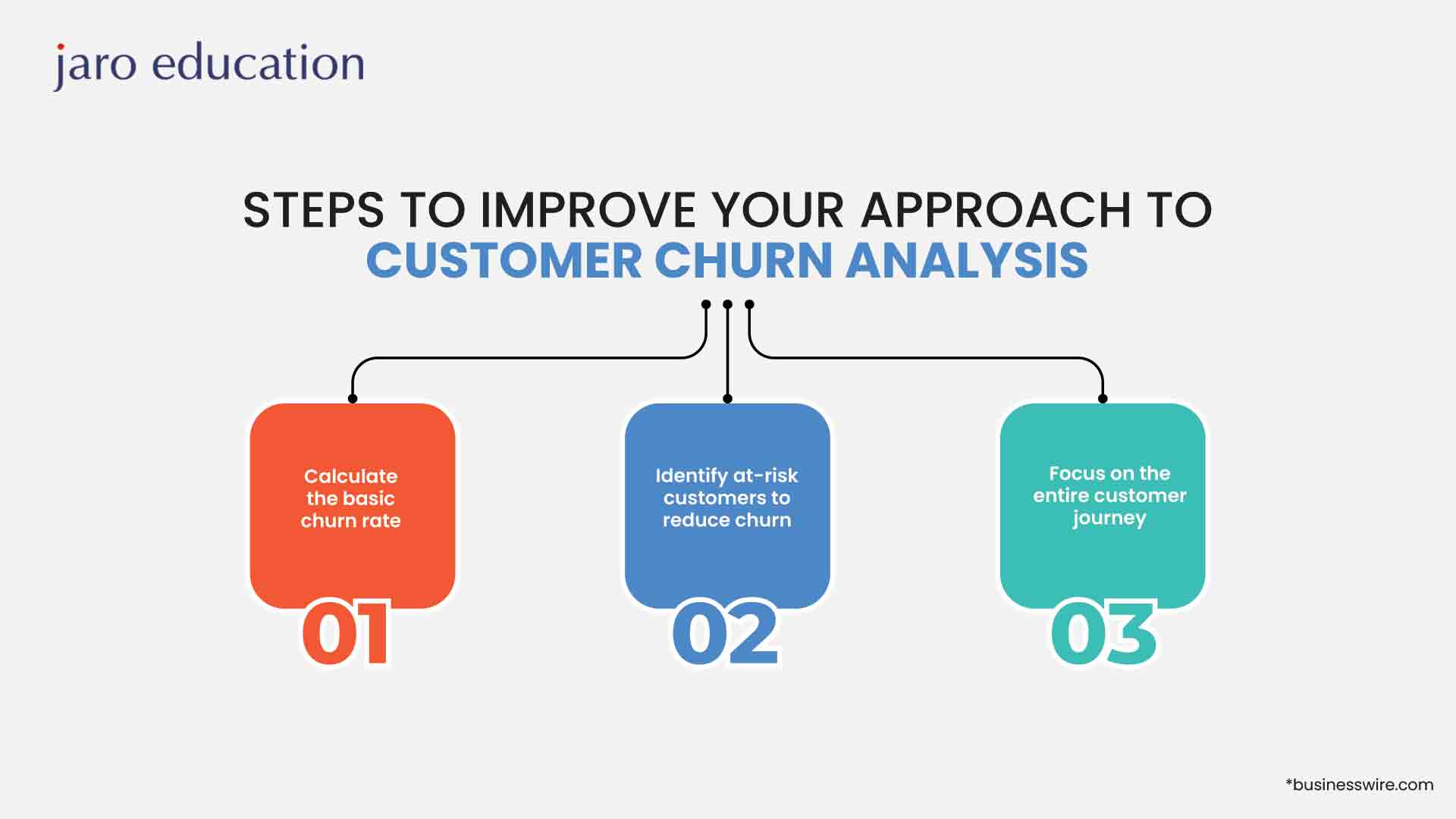Churn Analysis: Retain Your Customers in 3 Easy Steps
Table of Contents

- jaro education
- 29, March 2024
- 2:00 pm
In the dynamic landscape of business, churn analysis has become a crucial aspect for companies striving to maintain a strong and loyal customer base. As competition intensifies across industries, businesses are recognizing the need for effective customer churn analysis to identify patterns and devise strategies to reduce their churn rate. This blog delves into the significance of churn analysis and provides a comprehensive guide on how to retain customers through three fundamental steps.
Understanding Churn Analysis
Churn analysis involves evaluating customer attrition or churn rate by analyzing various metrics and patterns. It goes beyond identifying customers who have already left and aims to predict potential churners. By leveraging advanced analytics and data-driven insights, businesses can uncover the underlying reasons behind customer churn.
Understanding the customer journey and pinpointing critical touchpoints where customers disengage is essential. Churn analysis enables businesses to proactively address issues, enhance customer experience, and ultimately reduce churn.

*businesswire.com
Types of Churn
1. Voluntary Churn
Customers actively decide to terminate their subscription or cease using a service. This may result from dissatisfaction, finding better alternatives, or changes in their requirements.
2. Involuntary Churn
Customers leave due to circumstances beyond their control, such as credit card expiration, system failures, or other external factors.
Benefits of Churn Analysis for Businesses
Churn analysis proves to be a game-changer for businesses seeking sustainable growth. Here are the ways in which churn analysis equips business professionals:
Predictive Insights for Proactive Retention
Churn analysis empowers businesses with predictive insights. By identifying early signs of potential churn, businesses can take proactive measures to retain customers. Whether it’s personalized offers, targeted communication, or enhanced customer support, predictive analytics enables businesses to intervene before customers decide to switch.
Optimizing Customer Experience
Understanding the reasons behind churn allows businesses to optimize the overall customer experience. By addressing pain points and streamlining processes, businesses can create a more satisfying customer journey. Churn analysis sheds light on areas where improvements are needed, leading to enhanced customer satisfaction and loyalty.
Tailored Retention Strategies
Not all customers churn for the same reasons. Churn analysis allows businesses to segment customers based on behaviour, preferences, and other relevant factors. This segmentation enables the creation of tailored retention strategies for different customer segments. Whether it’s offering discounts, providing exclusive access, or implementing loyalty programs, businesses can address specific needs to retain diverse customer groups.
Customer churn can also have a significant impact on businesses, affecting revenue, brand reputation, and overall growth. Understanding the reasons behind churn is crucial for implementing effective retention strategies.
Steps to Reduce Churn
1. Personalized Customer Engagement
- Utilize data analytics to understand customer behaviour.
- Implement personalized marketing strategies based on individual preferences.
- Engage customers through targeted communication, addressing their specific needs and concerns.
2. Continuous Improvement of Products/Services
- Gather customer feedback through surveys and reviews.
- Use feedback to enhance and innovate products or services.
- Demonstrate a commitment to meeting and exceeding customer expectations.
3. Effective Customer Support
- Provide responsive and efficient customer support.
- Utilize AI-driven chatbots for immediate issue resolution.
- Establish multiple channels for customer communication, ensuring accessibility.
Churn Analysis Techniques
To conduct a successful churn analysis, businesses can employ various techniques, including:
Data Collection and Segmentation
Gathering relevant data and segmenting customers based on behaviour, preferences, and other factors.
Predictive Analytics
Utilizing predictive models to identify potential churners and take proactive measures.
Feedback Analysis
Analyzing customer feedback to understand pain points and areas for improvement.
Tailored Retention Strategies
Implementing personalized retention strategies based on the specific needs of different customer segments.
Key Metrics in Churn Analysis
Churn Rate
The churn rate is a fundamental metric, calculated as the number of customers lost divided by the total number of customers at the beginning of a specific period. A high churn rate signals potential issues that need to be addressed.
Customer Lifetime Value (CLV)
Customer Lifetime Value (CLV) estimates the total revenue a business can expect from a customer throughout their entire relationship. It assists in prioritizing customer segments and allocating resources effectively.
Customer Segmentation
Analyzing churn based on customer segments allows businesses to tailor retention strategies to specific groups. Different customer segments may have distinct needs and responses to retention efforts.
Importance of Customer Retention
Before delving into the steps to reduce churn, let’s emphasize the significance of customer retention. In a dynamic business environment, retaining existing customers is a key driver of sustainable growth. High churn rates can lead to increased marketing costs, as acquiring new customers is typically more expensive than retaining current ones.
Churn rate analysis is essential for businesses to identify patterns and trends related to customer attrition. It helps in developing proactive strategies to enhance customer satisfaction and loyalty. By focusing on customer retention, businesses not only secure a stable revenue stream but also benefit from positive word-of-mouth marketing and long-term customer relationships.
Effective Strategies for Customer Retention
Personalized Communication
Engaging customers through personalized communication based on their preferences and behaviours fosters a sense of value and loyalty. This may include personalized emails, offers, or content tailored to individual customer needs.
Customer Loyalty Programs
Implementing customer loyalty programs rewards customers for their continued engagement and loyalty. Such programs can include discounts, exclusive access, or other incentives to encourage repeat business.
Continuous Product Improvement
Regularly updating and enhancing products or services based on customer feedback ensures that businesses meet evolving needs. This ongoing improvement reduces the likelihood of churn by demonstrating a commitment to providing value and staying competitive.
Proactive Customer Support
Identifying and resolving customer issues before they escalate is crucial for enhancing satisfaction and reducing the chances of churn. Proactive customer support involves anticipating and addressing customer concerns promptly, reinforcing their confidence in the product or service.

Implement Three Steps to Effective Churn Analysis
Step 1: Data Collection and Segmentation
The first step in a successful churn analysis is thorough data collection and segmentation. Businesses need to gather relevant data related to customer interactions, preferences, and behaviours. Segmentation allows businesses to categorize customers into different groups based on common characteristics, enabling a more targeted analysis.
Utilizing advanced analytics tools, businesses can track customer interactions across various touchpoints. This includes online behaviour, purchase history, and engagement with marketing campaigns. By understanding the nuances of customer behaviour, businesses can identify patterns that may indicate an increased likelihood of churn.
Benefits
- Targeted Analysis: Segmenting customers allows for more targeted and focused analysis of specific customer groups.
- Early Identification: Early identification of potential churners enables businesses to take proactive measures before customers decide to leave.
- Personalized Approach: Segmentation facilitates the development of personalized retention strategies tailored to the specific needs of each customer segment.
Step 2: Predictive Analytics for Churn Prediction
The second step involves the use of predictive analytics to identify potential churners. Predictive models use historical data and machine learning algorithms to forecast future behaviour. In the context of churn analysis, predictive analytics helps businesses identify customers who are at a higher risk of churning in the future.
Benefits
- Proactive Retention: Predictive analytics allows businesses to be proactive in their approach to customer retention by identifying potential churners before they actually churn.
- Resource Optimization: By focusing efforts on customers identified as high-risk, businesses can optimize resources and tailor retention strategies for maximum impact.
- Continuous Improvement: Predictive models can be continually refined and improved based on ongoing data collection, ensuring the accuracy of churn predictions over time.
Step 3: Tailored Retention Strategies
Once potential churners are identified, the third step involves implementing tailored retention strategies. These strategies are crafted based on the specific needs and preferences of different customer segments. Effective retention strategies address the root causes of churn and aim to enhance the overall customer experience.
Benefits
- Customer-Centric Approach: Tailored retention strategies demonstrate a customer-centric approach, showing that businesses understand and value their customers.
- Improved Customer Experience: By addressing specific pain points and concerns, businesses can improve the overall customer experience, making it more likely that customers will choose to stay.
- Building Customer Loyalty: Successful implementation of retention strategies not only prevents churn but also contributes to building long-term customer loyalty.
The Role of Marketing Analytics
In today’s data-driven age, marketing analytics plays a pivotal role in understanding customer behaviour, predicting churn, and implementing targeted strategies. Analyzing customer data allows businesses to identify patterns, preferences, and potential indicators of dissatisfaction. By leveraging insights gained through marketing analytics, businesses can tailor their approach to each customer segment, ultimately reducing churn rates.
Master Churn Analysis with Prestigious IIM Mumbai
Explore the transformative Executive Certificate Programme in Advanced Marketing Analytics & Management at IIM Mumbai, where the spotlight is on the critical aspect of churn analysis. This program is meticulously crafted to empower professionals with cutting-edge analytical skills, strategically applied in real-world situations. Delve into the realm of data-driven marketing strategies, with a specific emphasis on the pivotal role of churn analysis within the curriculum. Uncover the secrets of shaping effective marketing strategies through insightful data analysis. For more details on this game-changing course, ignite your curiosity and reach out to Jaro Education. Elevate your marketing prowess – seize the opportunity for excellence!
IIM Mumbai's Case Study: A Testament to Tangible Results
IIM Mumbai’s Marketing Analytics programme is not just an educational endeavor; it’s a pathway to tangible success. The case study exemplifies how advanced analytics, when integrated into business practices, becomes a catalyst for positive change. By embracing these principles, businesses position themselves as pioneers in customer retention, fostering enduring relationships and ensuring sustained growth.
Churn Analysis Unveiled: A 3-Step Guide to Customer Retention
Dive into IIM Mumbai’s Marketing Analytics programme, where Churn Analysis takes center stage. The curriculum intricately focuses on:
Mastering Data Mining Techniques
Equip yourself with the skills to extract invaluable information from extensive datasets.
Harnessing Predictive Analytics
Learn to forecast customer behavior and proactively address potential churn.
Crafting Effective Segmentation Strategies
Understand the art of categorizing customer segments for targeted and impactful approaches.
The programme arms professionals with the expertise to implement advanced analytics tools, transforming raw data into actionable insights. By applying these techniques, businesses can tailor their services and communication to the unique needs of different customer segments.
Final Thoughts
In conclusion, effective churn analysis is integral to retaining customers in today’s competitive business landscape. Leveraging insights from programmes such as Advanced Marketing Analytics and Management offered by IIM Mumbai, businesses can adopt a proactive approach to customer retention. By understanding customer behaviours, implementing advanced analytics, and personalizing engagement strategies, companies can create a robust framework for reducing churn rates and fostering long-term customer loyalty.
Churn analysis is a vital aspect of sustaining a thriving business. The steps outlined for reducing churn emphasize the importance of personalized customer engagement, continuous improvement of products/services, and effective customer support. These strategies, coupled with the power of marketing analytics, create a robust framework for customer retention.
In a competitive landscape, the ability to retain customers is a strategic advantage. As businesses navigate the complexities of customer dynamics, incorporating churn analysis and marketing analytics will be instrumental in not only retaining existing customers but also attracting new ones.
This comprehensive approach to churn analysis and customer retention, enriched by insights from marketing analytics, ensures that businesses are well-equipped to face the challenges of an ever-evolving market. As we move towards an era where data-driven decisions are paramount, embracing these strategies becomes imperative for sustained success.
For those aspiring to excel in this dynamic field, the Executive Certificate Programme in Advanced Marketing Analytics and Management by IIM Mumbai, stands as a key enabler.
Frequently Asked Questions
Churn analysis involves assessing customer attrition or churn rate by analyzing metrics and patterns. It is crucial for businesses as it goes beyond identifying departed customers, aiming to predict potential churners. This proactive approach helps businesses retain customers by addressing underlying issues.
Predictive analytics uses historical data and machine learning algorithms to forecast future behaviour, helping identify potential churners. This empowers businesses to take proactive measures, such as personalized offers or enhanced support before customers decide to leave.
Customer segmentation categorizes customers based on behaviour and preferences, enabling targeted retention strategies. This step allows businesses to understand diverse customer needs and tailor approaches for specific segments, increasing the effectiveness of retention efforts.
Key metrics include churn rate, measuring the number of lost customers relative to the total; Customer Lifetime Value (CLV), estimating total revenue from a customer; and customer segmentation, analyzing churn based on distinct customer groups for tailored retention efforts.
The course equips professionals with advanced analytical skills, focusing on practical applications like data mining, predictive analytics, and segmentation.








